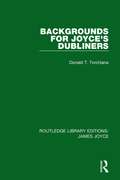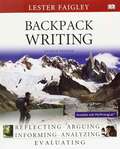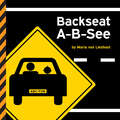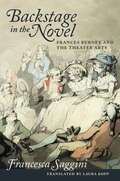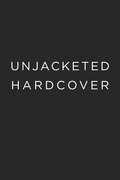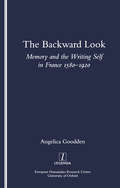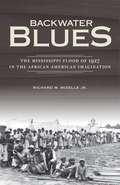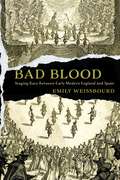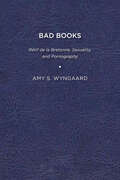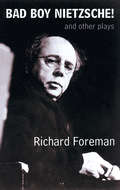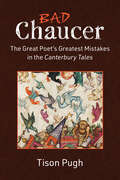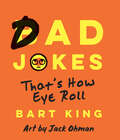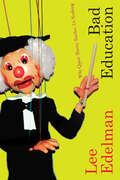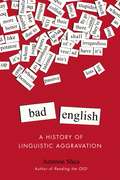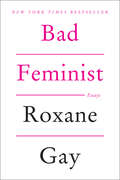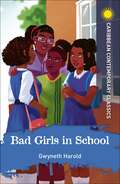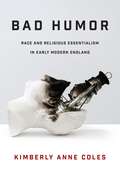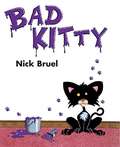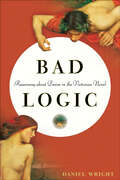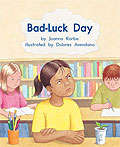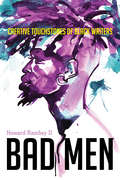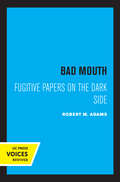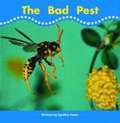- Table View
- List View
Backgrounds for Joyce's Dubliners (Routledge Library Editions: James Joyce #8)
by Donald T. TorchianaFirst published in 1986. Dubliners was James Joyce’s first major publication. Setting it at the turn of the century, Joyce claims to hold up a ‘nicely polished looking-glass’ to the native Irishman. In Backgrounds for Joyce’s Dubliners, the author examines the national, mythic, religious and legendary details, which Joyce builds up to capture a many-sided performance and timelessness in Irish life. Acknowledging the serious work done on Dubliners as a whole, in this study Professor Torchiana draws upon a wide range of published and unpublished sources to provide a scholarly and satisfying framework for Joyce’s world of the ‘inept and the lower middle class’. He combines an understanding of Joyce’s subtleties with a long-standing personal knowledge of Dublin. This title will make fascinating reading for scholars and students of Joyce’s writing as well as for those interested in early twentieth century Irish social history.
Backpack Writing
by Lester FaigleyFor college courses in Composition and Rhetoric. Backpack Writing, Fourth Edition presents writing, reading, and research processes dynamically, using a variety of visuals to illustrate how readers interact with texts and how writers compose. One of the first textbook authors to focus on multimedia composing, Lester Faigley employs his own advice to engage students in every step of the writing process – for both college composition and everyday life – and pulls back the curtain on how writers work. <p><p> Aligned with the learning goals for a first-year college writing course identified in the 2014 Outcomes Statement from the Council of Writing Program Administrators, Backpack Writing gives students the support they need to succeed in first-year composition, in their other courses, and in their careers. In the Fourth Edition, students can also practice and explore what they’ve learned chapter-by-chapter with interactive MyWritingLab tools, assignments, and projects.
Backseat A-B-See
by Maria van Lieshout“Just when you thought there couldn’t possibly be another idea for an alphabet book—buckle up for this one! . . . Clever [and] fun.” —Kirkus Reviews (starred review).Vroom! Vroom! Whether on a cross-country road trip or a quick jaunt across town, there’s no end to what a child can see from the backseat of a car. Using familiar road signs, this striking book introduces little ones not just to the alphabet but also to the world around them.Equally perfect for transportation-obsessed children and those just learning to read, this fresh and dynamic picture book will entertain and educate at home, in the classroom, and on the go.“Backseat drivers will enjoy learning the language of the road along with their ABCs.” —Publishers Weekly“The alphabet. In road signs. Genius.” —Wired
Backstage in the Novel: Frances Burney and the Theater Arts
by Francesca Saggini Laura KoppIn Backstage in the Novel, Francesca Saggini traces the unique interplay between fiction and theater in the eighteenth century through an examination of the work of the English novelist, diarist, and playwright Frances Burney. Moving beyond the basic identification of affinities between the genres, Saggini establishes a literary-cultural context for Burney's work, considering the relation between drama, a long-standing tradition, and the still-emergent form of the novel. Through close semiotic analysis, intertextual comparison, and cultural contextualization, Saggini highlights the extensive metatextual discourse in Burney's novels, allowing the theater within the novels to surface. Saggini's comparative analysis addresses, among other elements, textual structures, plots, characters, narrative discourse, and reading practices. The author explores the theatrical and spectacular elements that made the eighteenth-century novel a hybrid genre infused with dramatic conventions. She analyzes such conventions in light of contemporary theories of reception and of the role of the reader that underpinned eighteenth-century cultural consumption. In doing so, Saggini contextualizes the typical reader-spectator of Burney's day, one who kept abreast of the latest publications and was able to move effortlessly between "high" (sentimental, dramatic) and "low" (grotesque, comedic) cultural forms that intersected on the stage. Backstage in the Novel aims to restore to Burney's entire literary corpus the dimensionality that characterized it originally. It is a vivid, close-up view of a writer who operated in a society saturated by theater and spectacle and who rendered that dramatic text into narrative. More than a study of Burney or an overview of eighteenth-century literature and theater, this book gives immediacy to an understanding of the broad forces informing, and channeled through, Burney's life and work.
Backstory 5: Interviews with Screenwriters of the 1990s
by Patrick McgilliganPatrick McGilligan continues his celebrated interviews with exceptional screenwriters with Backstory 5, focusing on the 1990s. The thirteen featured writers are not confined to the 1990s, but their engrossing, detailed, and richly personal stories create, in Patrick's words, "a snapshot of a profession in motion."
The Backward Look: Memory and Writing Self in France 1580-1920
by Angelica Goodden"Theories of memory and fictional recreations of the remembering mind have occupied a central place in French literature since Montaigne. The author investigates the shifting relation between cognitive or ""scientific"" memory and emotional or spiritual recollection in a series of major writers from the 16th to the 20th centuries. Her study focuses on the 18th century, where the interplay between memory and imagination and the link between self-knowledge and self-presentation are shown to be exceptionally fertile. The philosophical, scientific and fictional writings of Diderot and the novels and autobiographical works of Rousseau are central to this ground-breaking work, which should be of interest to all readers concerned with the specificity of the French literary tradition."
Backwater Blues: The Mississippi Flood of 1927 in the African American Imagination
by Richard M. Mizelle Jr.The Mississippi River flood of 1927 was the most destructive river flood in U.S. history, reshaping the social and cultural landscape as well as the physical environment. Often remembered as an event that altered flood control policy and elevated the stature of powerful politicians, Richard M. Mizelle Jr. examines the place of the flood within African American cultural memory and the profound ways it influenced migration patterns in the United States.In Backwater Blues, Mizelle analyzes the disaster through the lenses of race and charity, blues music, and mobility and labor. The book&’s title comes from Bessie Smith&’s &“Backwater Blues,&” perhaps the best-known song about the flood. Mizelle notes that the devastation produced the richest groundswell of blues recordings following any environmental catastrophe in U.S. history, with more than fifty songs by countless singers evoking the disruptive force of the flood and the precariousness of the levees originally constructed to protect citizens. Backwater Blues reveals larger relationships between social and environmental history. According to Mizelle, musicians, Harlem Renaissance artists, fraternal organizations, and Creole migrants all shared a sense of vulnerability in the face of both the Mississippi River and a white supremacist society. As a result, the Mississippi flood of 1927 was not just an environmental crisis but a racial event. Challenging long-standing ideas of African American environmental complacency, Mizelle offers insights into the broader dynamics of human interactions with nature as well as ways in which nature is mediated through the social and political dynamics of race.Includes discography.
Bad Blood: Staging Race Between Early Modern England and Spain (RaceB4Race: Critical Race Studies of the Premodern)
by Emily WeissbourdBad Blood explores representations of race in early modern English and Spanish literature, especially drama. It addresses two different forms of racial ideology: one concerned with racialized religious difference—that is, the notion of having Jewish or Muslim “blood”—and one concerned with Blackness and whiteness. Shakespeare’s Othello tells us that he was “sold to slavery” in his youth, a phrase that evokes the Atlantic triangle trade for readers today. For many years, however, scholars have asserted that racialized slavery was not yet widely understood in early modern England, and that the kind of enslavement that Othello describes is related to Christian-Muslim conflict in the Mediterranean rather than the rise of the racialized enslavement of Afro-diasporic subjects.Bad Blood offers a new account of early modern race by tracing the development of European racial vocabularies from Spain to England. Dispelling assumptions, stemming from Spain’s historical exclusion of Jews and Muslims, that premodern racial ideology focused on religious difference and purity of blood more than color, Emily Weissbourd argues that the context of the Atlantic slave trade is indispensable to understanding race in early modern Spanish and English literature alike. Through readings of plays by Shakespeare, Lope de Vega, and their contemporaries, as well as Spanish picaresque fiction and its English translations, Weissbourd reveals how ideologies of racialized slavery as well as religious difference come to England via Spain, and how both notions of race operate in conjunction to shore up fantasies of Blackness, whiteness, and “pure blood.” The enslavement of Black Africans, Weissbourd shows, is inextricable from the staging of race in early modern literature.
Bad Books: Rétif de la Bretonne, Sexuality, and Pornography
by Amy S. WyngaardBad Books reconstructs how the eighteenth-century French author Nicolas-Edme Rétif de la Bretonne and his writings were at the forefront of the development of modern conceptions of sexuality and pornography. Although certain details are well known (for example, that Rétif’s 1769 treatise on prostitution, Le Pornographe, is the work from which the term pornography is derived, or that he was an avid foot and shoe fetishist), much of this story has been obscured and even forgotten: how the author actively worked to define the category of obscenity and the modern pornographic genre; how he coined the psycho-sexual term “fetish” and played a central role in the formation of theories of sexual fetishism in the late nineteenth and early twentieth centuries. Thus this book is also about literary history and how it is written: it explores how Rétif, perceived as a bad author in both senses of the term, and his contributions were glossed over or condemned, such that the originality of his texts has still not been fully established. Published by University of Delaware Press. Distributed worldwide by Rutgers University Press.
Bad Boy Nietzsche! and Other Plays
by Richard ForemanRichard Foreman has been at the leading edge of the theatrical avant-garde in the United States and throughout the world since 1968. His legendary productions, written and directed by him at his Ontological-Hysteric Theatre have influenced two generations of theater artists. This new anthology collects plays written and performed over six years, including Now That Communism Is Dead My Life Feels Empty, Maria del Bosco, Panic (How to Be Happy!), Bad Boy Nietzsche!, Bad Behavior and King Cowboy Rufus Rules the Universe.Richard Foreman founded the Ontological-Hysteric Theatre in 1968. The theater is currently in the historic St. Marks Church, where he rehearses and produces one of his new plays each year, each play performing for 16 weeks every winter.
Bad Chaucer: The Great Poet’s Greatest Mistakes in the Canterbury Tales
by Tison PughAcclaimed for centuries as the “Father of English Literature,” Geoffrey Chaucer enjoys widespread and effusive praise for his classic Canterbury Tales—and rightfully so. Still, even the greatest of authors cannot claim perfection, and so Bad Chaucer: The Great Poet’s Greatest Mistakes in the Canterbury Tales analyzes his various missteps, missed opportunities, and other blunders in this peerless masterpiece. From a vexing catalog of trees in the Knight’s Tale to the flirtations with blasphemy in the Parson’s Tale, this volume progresses through the Canterbury Tales story by story, tale by tale, pondering the most egregious failing of each in turn. Viewed collectively, Chaucer’s troubles stem from clashing genres that disrupt interpretive clarity, themeless themes that undermine any message a tale might convey, mischaracterized characters who act without clear motivation, purposeful and otherwise pleasureful badness that show Chaucer’s appreciation for the humor of bad literature, and outmoded perspectives that threaten to alienate modern readers. Badness is not always to be lamented but often celebrated, even cherished, for badness infuses artistic creations with the vitality that springs from varied responses, spirited engagements, and the inherent volatility of enjoying literature. On the whole, Bad Chaucer: The Great Poet’s Greatest Mistakes in the Canterbury Tales swerves literary criticism in a new direction by examining the provocative question, for too long overlooked, of what this great author got wrong.
Bad Dad Jokes: That's How Eye Roll
by Bart KingA goofy book celebrating the Dad Joke lifestyle?packed with jokes and wordplay for your favorite punster.Bart King’s Bad Dad Jokes covers every aspect of the most simultaneously loathed and beloved joke form of all time: the pun. Because “Dad Humor” should be practiced by everyone (regard-less of age, gender, or family status) this book serves to encourage creative thinking and pun-ning habits for everyone!Learn how to properly deliver a pun (whether written, visual, or verbal) and how to pretend you’re sorry for your Dad Joke (even when you’re not). Includes: quality pre-loaded puns, the taxonomy of the different types of wordplay, famous punsters, and Great Moments in Dad Joke History.Featuring illustrations by Pulitzer Prize–winning cartoonist Jack Ohman.
Bad Education: Why Queer Theory Teaches Us Nothing (Theory Q)
by Lee EdelmanLong awaited after No Future, and making queer theory controversial again, Lee Edelman’s Bad Education proposes a queerness without positive identity—a queerness understood as a figural name for the void, itself unnamable, around which the social order takes shape. Like Blackness, woman, incest, and sex, queerness, as Edelman explains it, designates the antagonism, the structuring negativity, preventing that order from achieving coherence. But when certain types of persons get read as literalizing queerness, the negation of their negativity can seem to resolve the social antagonism and totalize community. By translating the nothing of queerness into the something of “the queer,” the order of meaning defends against the senselessness that undoes it, thus mirroring, Edelman argues, education’s response to queerness: its sublimation of irony into the meaningfulness of a world. Putting queerness in relation to Lacan’s “ab-sens” and in dialogue with feminist and Afropessimist thought, Edelman reads works by Shakespeare, Jacobs, Almodóvar, Lemmons, and Haneke, among others, to show why queer theory’s engagement with queerness necessarily results in a bad education that is destined to teach us nothing.
Bad English
by Ammon SheaThe author of Reading the OED presents an eye-opening look at language "mistakes" and how they came to be accepted as correct--or not. English is a glorious mess of a language, cobbled together from a wide variety of sources and syntaxes, and changing over time with popular usage. Many of the words and usages we embrace as standard and correct today were at first considered slang, impolite, or just plain wrong. Whether you consider yourself a stickler, a nitpicker, or a rule-breaker in the know, Bad English is sure to enlighten, enrage, and perhaps even inspire. Filled with historic and contemporary examples, the book chronicles the long and entertaining history of language mistakes, and features some of our most common words and phrases, including: Decimate Hopefully Enormity That/which Enervate/energize Bemuse/amuse Literally/figuratively Ain't Irregardless Socialist OMG Stupider Lively, surprising, funny, and delightfully readable, this is a book that will settle arguments among word lovers--and it's sure to start a few, too.
Bad Feminist: Essays
by Roxane Gay“Roxane Gay is so great at weaving the intimate and personal with what is most bewildering and upsetting at this moment in culture. She is always looking, always thinking, always passionate, always careful, always right there.” — Sheila Heti, author of How Should a Person Be?A New York Times BestsellerBest Book of the Year: NPR • Boston Globe • Newsweek • Time Out New York • Oprah.com • Miami Herald • Book Riot • Buzz Feed • Globe and Mail (Toronto) • The Root • Shelf AwarenessA collection of essays spanning politics, criticism, and feminism from one of the most-watched cultural observers of her generationIn these funny and insightful essays, Gay takes us through the journey of her evolution as a woman (Sweet Valley High) of color (The Help) while also taking readers on a ride through culture of the last few years (Girls, Django in Chains) and commenting on the state of feminism today (abortion, Chris Brown). The portrait that emerges is not only one of an incredibly insightful woman continually growing to understand herself and our society, but also one of our culture.Bad Feminist is a sharp, funny, and spot-on look at the ways in which the culture we consume becomes who we are, and an inspiring call-to-arms of all the ways we still need to do better, coming from one of our most interesting and important cultural critics.
Bad Girls in School
by Gwyneth HaroldThere have been many great and enduring works of literature by Caribbean authors over the last century. The Caribbean Contemporary Classics collection celebrates these deep and vibrant stories, overflowing with life and acute observations about society.Three girls are on the brink of expulsion from the respected Redeemer College: 'Failure to complete term assignments, ... using foul language ... stealing another student's cell phone ... persistent lateness for English classes. Breaching the behaviour code ...' Katreena, Ta Jeeka and Caledonia are about to be written off. This insightful book unsentimentally exposes the fault lines through society, and the deep effects they have on individuals. It describes the choices people make and the decisions they feel forced in to. Maturing into young adulthood, these girls each have to make, or lose, their way, in their own way. What difference can one teacher make?
Bad Girls in School (Caribbean Modern Classics)
by Gwyneth HaroldThere have been many great and enduring works of literature by Caribbean authors over the last century. The Caribbean Contemporary Classics collection celebrates these deep and vibrant stories, overflowing with life and acute observations about society.Three girls are on the brink of expulsion from the respected Redeemer College: 'Failure to complete term assignments, ... using foul language ... stealing another student's cell phone ... persistent lateness for English classes. Breaching the behaviour code ...' Katreena, Ta Jeeka and Caledonia are about to be written off. This insightful book unsentimentally exposes the fault lines through society, and the deep effects they have on individuals. It describes the choices people make and the decisions they feel forced in to. Maturing into young adulthood, these girls each have to make, or lose, their way, in their own way. What difference can one teacher make?
Bad Humor: Race and Religious Essentialism in Early Modern England
by Kimberly Anne ColesRace, in the early modern period, is a concept at the crossroads of a set of overlapping concerns of lineage, religion, and nation. In Bad Humor, Kimberly Anne Coles charts how these concerns converged around a pseudoscientific system that confirmed the absolute difference between Protestants and Catholics, guaranteed the noble quality of English blood, and justified English colonial domination.Coles delineates the process whereby religious error, first resident in the body, becomes marked on the skin. Early modern medical theory bound together psyche and soma in mutual influence. By the end of the sixteenth century, there is a general acceptance that the soul's condition, as a consequence of religious belief or its absence, could be manifest in the humoral disposition of the physical body. The history that this book unfolds describes developments in natural philosophy in the early part of the sixteenth century that force a subsequent reconsideration of the interactions of body and soul and that bring medical theory and theological discourse into close, even inextricable, contact. With particular consideration to how these ideas are reflected in texts by Elizabeth Cary, John Donne, Ben Jonson, William Shakespeare, Edmund Spenser, Mary Wroth, and others, Coles reveals how science and religion meet nascent capitalism and colonial endeavor to create a taxonomy of Christians in Black and White.
Bad Kitty (Bad Kitty)
by Nick BruelNIMAC-sourced textbook <P><P>From the creator of The New York Times bestseller Boing! comes Bad Kitty, the riotous story of a cat gone berserk -- four times over an in alphabetical order each time. Kitty is not happy hen she's told that her favorite foods are all gone and all that's left are Asparagus, Beets, Cauliflower, Dill...and 22 other equally unappealing vegetables. So she: Ate my homework, Bit grandma, Clawed the curtains, Damaged the dishes, and so on, through Z. Only when tastier things arrive (an Assortment of Anchovies, Buffalo Burritos, Chicken Cheesecake...) does she Apologize to Grandma.
Bad Logic: Reasoning about Desire in the Victorian Novel
by Daniel WrightHow did the Victorians think about love and desire?"Reader, I married him," Jane Eyre famously says of her beloved Mr. Rochester near the end of Charlotte Brontë’s novel. But why does she do it, we might logically ask, after all he’s put her through? The Victorian realist novel privileges the marriage plot, in which love and desire are represented as formative social experiences. Yet how novelists depict their characters reasoning about that erotic desire—making something intelligible and ethically meaningful out of the aspect of interior life that would seem most essentially embodied, singular, and nonlinguistic—remains a difficult question.In Bad Logic, Daniel Wright addresses this paradox, investigating how the Victorian novel represented reasoning about desire without diluting its intensity or making it mechanical. Connecting problems of sexuality to questions of logic and language, Wright posits that forms of reasoning that seem fuzzy, opaque, difficult, or simply "bad" can function as surprisingly rich mechanisms for speaking and thinking about erotic desire. These forms of "bad logic" surrounding sexuality ought not be read as mistakes, fallacies, or symptoms of sexual repression, Wright asserts, but rather as useful forms through which novelists illustrate the complexities of erotic desire.Offering close readings of canonical writers Charlotte Brontë, Anthony Trollope, George Eliot, and Henry James, Bad Logic contextualizes their work within the historical development of the philosophy of language and the theory of sexuality. This book will interest a range of scholars working in Victorian literature, gender and sexuality studies, and interdisciplinary approaches to literature and philosophy.
Bad-Luck Day (Fountas & Pinnell LLI Green #Level J, Lesson 109)
by Joanna KorbaFountas and Pinnell Leveled Literacy Intervention Green System -- 1st Grade
Bad Men: Creative Touchstones of Black Writers
by Howard Rambsy Ii.How have African American writers drawn on "bad" black men and black boys as creative touchstones for their evocative and vibrant art? This is the question posed by Howard Rambsy’s new book, which explores bad men as a central, recurring, and understudied figure in African American literature, and music. By focusing on how various iterations of the bad black man figure serve as creative muse and inspiration for literary production, Rambsy puts a wide variety of contemporary African American literary and cultural works in conversation with creativity research for the first time.Employing concepts such as playfulness, productivity, divergent thinking, and problem finding, Rambsy examines the works of a wide range of writers—including Elizabeth Alexander, Amiri Baraka, Paul Beatty, Ta-Nehisi Coates, Tyehimba Jess, Trymaine Lee, Adrian Matejka, Aaron McGruder, Evie Shockley, and Kevin Young—who have drawn on notions of bad black men and boys to create innovative and challenging works in a variety of genres. Through groundbreaking readings, Rambsy demonstrates the fruitfulness of viewing black literary art through the lens of creativity research.
Bad Mouth: Fugitive Papers on the Dark Side (Quantum Books)
by Robert M. AdamsThis title is part of UC Press's Voices Revived program, which commemorates University of California Press’s mission to seek out and cultivate the brightest minds and give them voice, reach, and impact. Drawing on a backlist dating to 1893, Voices Revived makes high-quality, peer-reviewed scholarship accessible once again using print-on-demand technology. This title was originally published in 1977.
